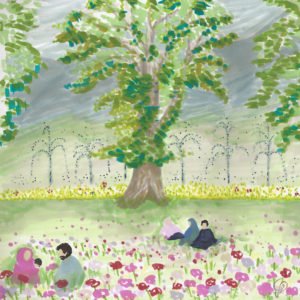Dr Mubashir Hussain Haji
Pediatrician and Neonotologist
mobzgaz@gmail.com

Every year, with the beginning of harud, there occurs to be a surge in the respiratory ailments like Cough and cold, coryza, sore throat, fever, rhinitis, hoarseness of voice etc., become the talk of the town for the patients of the valley. This trend continues throughout harud and shows upsurge in the wandeh with waxing and waning character. It again resurges in soanth–the beginning of which is followed by the advent of migratory birds, especially swallows. The one commonality between these two seasons is the transition of weather: From hot to cold in harud and from cold to warm in soanth. Poashteer starts with the sprouting of flower buds in soanth and continues till bahar.
Considering the pandemic engulfing the whole globe, this issue might not seem as relevant right now. But believe me; it is connected to the pandemic: Both have almost the same symptoms. We already stepped into soanth on 21st March –the day we would once celebrates Novrooz. Poashteer has a great deal of impact on our quality of life, work environment, and personal income apart from the burden it puts on our already crumbling health system. We need to take it seriously, more than ever, now.
The illnesses poashteer brings with it are viral in nature: Influenza virus, Respiratory Syncytial Virus (RSV), and Adenovirus amongst others. Even in extremely developed countries such as USA, an estimated 11000-45000 children, less than 18 years of age, are hospitalised annually as a result of seasonal influenza. Since 2004, in USA, 37-171 influenza related deaths have occurred every year with a peak of 358 such deaths in 2009 during H1N1 pandemic. In our society, around70-80 % of the cases are related to influenza like illnesses in paediatric population during harud, wandeh and soanth, literally pushing the health apparatus into a gasping state.
While each and every child is susceptible to contract the illness at any point of time, this part of population is at more risk for developing the illness and its related Complications:
- Children less than 2 years of age.
- People with pulmonary (lung diseases), cardiovascular (heart diseases), renal (kidney diseases), hepatic (liver diseases), haematological (blood diseases), metabolic, neurological (brain diseases), neuro-developmental conditions like epilepsy (fits and seizures locally known as Laaren), cerebral palsy etc.
- Person with immunosuppression (One with weak immune system either due to some diseases like AIDS or due to some medication like anti-cancer drugs).
- Adolescents who are pregnant or post-partum (2 weeks after delivery)
Children on long term aspirin or salicylate containing medications. - Extremely obese case (BMI>40).

- Residents of long term care facilities (like children studying in madrasses, boarding schools, orphanages, shelter homes etc.).
- Hospitalised patients.
Every year, 3-4 virus, types or sub types, co-circulate. Although one sub type predominates, it is difficult to predict the subtype likely to predominate in the coming poashteer months. Thus the influenza vaccine varies annually and contains 3-4 antigens representing the expected circulating types.
Common clinical manifestation
Fever
Myalgia (body aches)
Chills
Headaches
Malaise (feeling of tiredness)
Anorexia (loss of appetite)
Less common symptoms
Coryza, pharyngitis, and dry cough.
Abdominal pain, vomiting, and diarrhoea may also occur. The typical duration of fever is 3-5 days, cough may persist for longer.
Complications
Pneumonia and otitis media(middle ear infection) are common, mostly occur in children with underlying co-morbidities.
Warring signs
- Toxic appearances.
- High fever that can last up to 2 weeks or more.
- Breathlessness.
- Agitation, irritability, excessive crying.
- Cyanosis (blush discoloration of body parts mainly hips, tongue, fingers etc.).
- Sub costal/inter costal retraction (use of accessory muscle for respiration).
- Chest pain, neck pain.
- Shock.
Diagnosis and Rx
- In our setup, however, diagnosis is mainly clinical, while epidemiological and laboratory parameters may guide for better treatment. For influenza, rapid diagnostic tests, RT-PCR and serological tests are available.
- Treatment is mainly supportive. Antivirals can be used after consultation with the doctor (oseltamivir and baloxavirmarboxil).
- Rest
- Adequate fluid intake
Preventions
Vaccination is best and most effective.
Influenza vaccine is 40-60 % effective in reducing risk of lab confirmed influenza illnesses. Vaccine effectiveness can vary year to year among different age and risk groups.
Recommendation of vaccine
US advisory committee on immunization practice (ACIP) 2008-09 guidelines:
All children from 6 months to 18 years should be vaccinated.
Since 2010-11 annual flu vaccination recommended for every child of 6 months age and older.
Two categories of vaccines
Live attenuated and inactive.
In our setup, only inactivated vaccines are available.
Special instructions for 2 months -8 years of age
Has the child received two doses of inactivated influenza vaccine in the previous year?
Yes: Single dose of new year vaccine is recommended.
No: Two doses of New year’s vaccine, administered at least 28 days apart, are recommended.
Ideally vaccination should be given before the onset of influenza circulation in community (usually by the end of October every year).
In addition to vaccination routine hygienic principles should be followed along with coughing and sneezing etiquettes, avoiding dingy-dungy surroundings, overcrowded places etc, as a necessity for prevention from other common viral illnesses including the currently threatening SARS-Cov-2.


